Session Summary: SES119—The 21st-Century Physician: What SI2025 and CLER are Teaching Us
In one of the final sessions at the 2018 Annual Educational Conference on Sunday, March 4, a panel of ACGME executives, deans, a patient safety expert, and a resident spoke to the crowd about how medicine is changing and graduate medical education may need to evolve to serve patients well into the 21st century.
Director of the Department of Veterans Affairs National Center for Patient Safety James Bagian, MD, and ACGME Vice President, CLER Robin Wagner, RN, MHSA, kicked off the conversation about the Clinical Learning Environment Review (CLER) Program.
The pair noted that over the past several years the CLER Program has interviewed more than 50,000 faculty members and program directors, and over 25,000 residents, and has completed more than 1,000 site visits. Early findings show:
- Clinical learning environments vary widely in their capacity for handling patient safety and quality improvements. Organizations are making efforts to improve, and the goal is to accelerate that change.
- Graduate medical education (GME) needs to integrate better with the clinical learning environment. When health care executives focus on integration and invest in their clinical workforce, they report improvements in patient care. Next steps: Work together more closely for immediate and long-term gains.
- Reorganization and expansion of health care systems is happening at a rapid pace, creating challenges and considerations for the future, even overseas. Retail clinics and other models of health care are on the rise.
Lawrence Opas, MD, associate dean of GME and designated institutional official (DIO) at the Keck School of Medicine spoke about the role of technology as a key factor in the delivery of health care in the future. Physicians will need to be able to interpret and integrate technology from a large number of sources—biometric, electronic health records, artificial intelligence—and to identify system errors and improvements sooner.
Diane Hartmann, MD, dean and DIO at the Strong Memorial Hospital of the University of Rochester spoke next, and began by emphasizing the need to think about what GME will be doing seven years from now.
“I think about all the things my organization and others in the room have to do now,” she said. “If we don’t, we will not equip our physicians with the tools they need for the changing health care world.”
She talked about the importance of teams and team goals, and stressed that the role of the physician may shift back and forth between leader and consultant. She spoke of the recent Sponsoring Institution 2025 Report, which has provided substantial insights into how Sponsoring Institutions may serve patients and the GME community going forward. In this future state, Dr. Hartmann said, teams will look different, and physicians will have to enhance their communication skills to be the best healers they can be.
Aspects of training will need to be completed virtually, integrating artificial intelligence, and work-life balance will be even more important, with an expectation that systems will support learning, among other changes.
Anai Kothari, MD, MS, a fourth-year surgery resident at Loyola University Medical School provided the critical resident perspective. He asked the audience, “What is this future leading us toward? What does this look like for more than 130,000 residents? Who are our patients?” The concept of what a doctor is now is changing, and there is a paradigm shift within the new generation of physicians—the millennial generation.
He gave the example that millennials have never heard a busy tone. Technology is integrated into what they do, and this generation of physicians expects the same tools in the health care system to take care of patients in the 21st century.
Text messages and telemedicine topped the list of changes embraced by the millennial physician. And perhaps the most important message for the future was the importance of maintaining joy and well-being in work. “This is what excites me the most,” said Dr. Kothari. “Residents already have a vision of what they want moving forward.”
Here’s what that looks like:
- Time with patients
- Teamwork
- Decrease in non-clinical work
- Supportive environment
- Progressive autonomy
ACGME Senior Vice President, Institutional Accreditation Kevin Weiss, MD, MPH closed out the session with a note that there is even more information being gathered in different parts of the ACGME to help inform physician training and prepare for the future of medicine.
With the learnings from these initiatives, it is the ACGME’s hope that residents and practicing physicians will have the insights, resources, and training needed to support them in their future practice and lifelong learning.








